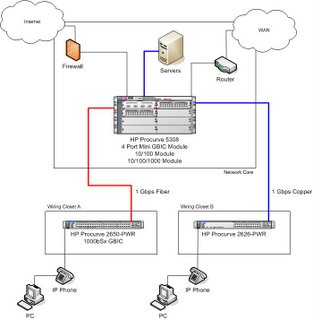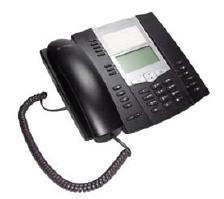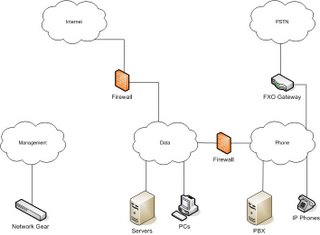So, you want to install a VoIP / IP Telephony system. How do you prepare your LAN / WAN for this new application where timing is critical? How well your VoIP system runs will depend largely on how good your network infrastructure is.
Cabling - Make sure your network cabling is up to standards. Properly run Cat 5/5e/6 cabling with patch panels in the closets & wall jacks on the wall. Use manufactured patch cords. And if you really want to be sure it is right, have it certified by a cabling contractor.
Network Switching - This is one of the harder pieces and critical to the success of your deployment. I won't pretend to be able to describe how to properly design a network in a few paragraphs because every organization is different. Here are some basics though.
- Think about the core of your network. If everything ties back to a single location things are pretty simple. Where are your servers, your wiring closets, your wide area connectivity & your outside world connectivity? Start at the core and work out from there with a simple star topology (don't try to connect closet to closet to closet, instead connect each closet to the core directly).
- What other critical line of business applications do you run that may need to be considered in the design.
- What do you have for existing equipment that you might be able to utilize?
- Figure out which manufacturer's gear you want to utilize and learn the different models and their options. This is important! Know your product!
- How are you going to power your hard phones? PoE switches, mid-spans (power injectors) or power bricks at each desk?
- How about power protection? Most UPS manufacturers have calculators on their web sites that allow you to estimate consumption and run times of their gear.
Here's an example of a physical network design with a core server room (the core closet area is sometimes referred to as the MDF and the remote closets as IDFs).

Above we see the two closets linked back to the core at 1 Gbps, one with fiber because of distance from the core, and the second with Cat 5e / 6 copper. The servers all connect in to the core network switch at 1 Gbps and the firewall and router connect in to the core. Simple, clean efficient.
I like the HP switching gear (it's about 60% of the cost of an equivalent Cisco design, lifetime replacement, support and software updates). They have a nice broad range of products, their QOS seems pretty good and they are easy to configure. Don't' get me wrong, I like the Cisco stuff too and design plenty of networks with it. I just think I get more bang for the buck with HP. If I need to cheap things out, Linksys has some inexpensive managed PoE switches and so does Dell, Netgear and DLink.
Try to stick with managed switches so that you can create VLANs. Most modern managed switches will support Quality of Service (QOS). Some of the really cheap PoE switches are unmanaged (Netgear, DLink have some models like that).
Adtran makes some nice little stackable PoE switches (1224 series) and they even have one with an integrated router module (1224 r). This makes for a nice all in one device at remote WAN connected locations.
Don't have the coin for all new fancy gear? First off, prepare yourself for small voice quality issues. If you can live with that (hey we all put up with cell phones right?), take the above network design principles into account. Good cabling, star topology, avoid linking switch to switch to switch. Oh, and forget about trying to use any old hubs you have... switches only.
Remember, cabling and switching are the foundation of your VoIP deployment. The rest of the house is only as good as the foundation. Take the time to get it right and people won't be reaching for your throat. Next article I'll get into VLAN design and maybe QOS... we'll see how long it runs...
 The 57i has a large LCD for desi-less operation. There is an optional 20 button side-car for the phone (up to 3 can be used) which has the same large LCD on it. Additionally there will be a 57i CT with a cordless handset (a la 480i CT). The handset looks identical to the handset that comes with the 480i CT.
The 57i has a large LCD for desi-less operation. There is an optional 20 button side-car for the phone (up to 3 can be used) which has the same large LCD on it. Additionally there will be a 57i CT with a cordless handset (a la 480i CT). The handset looks identical to the handset that comes with the 480i CT. 


